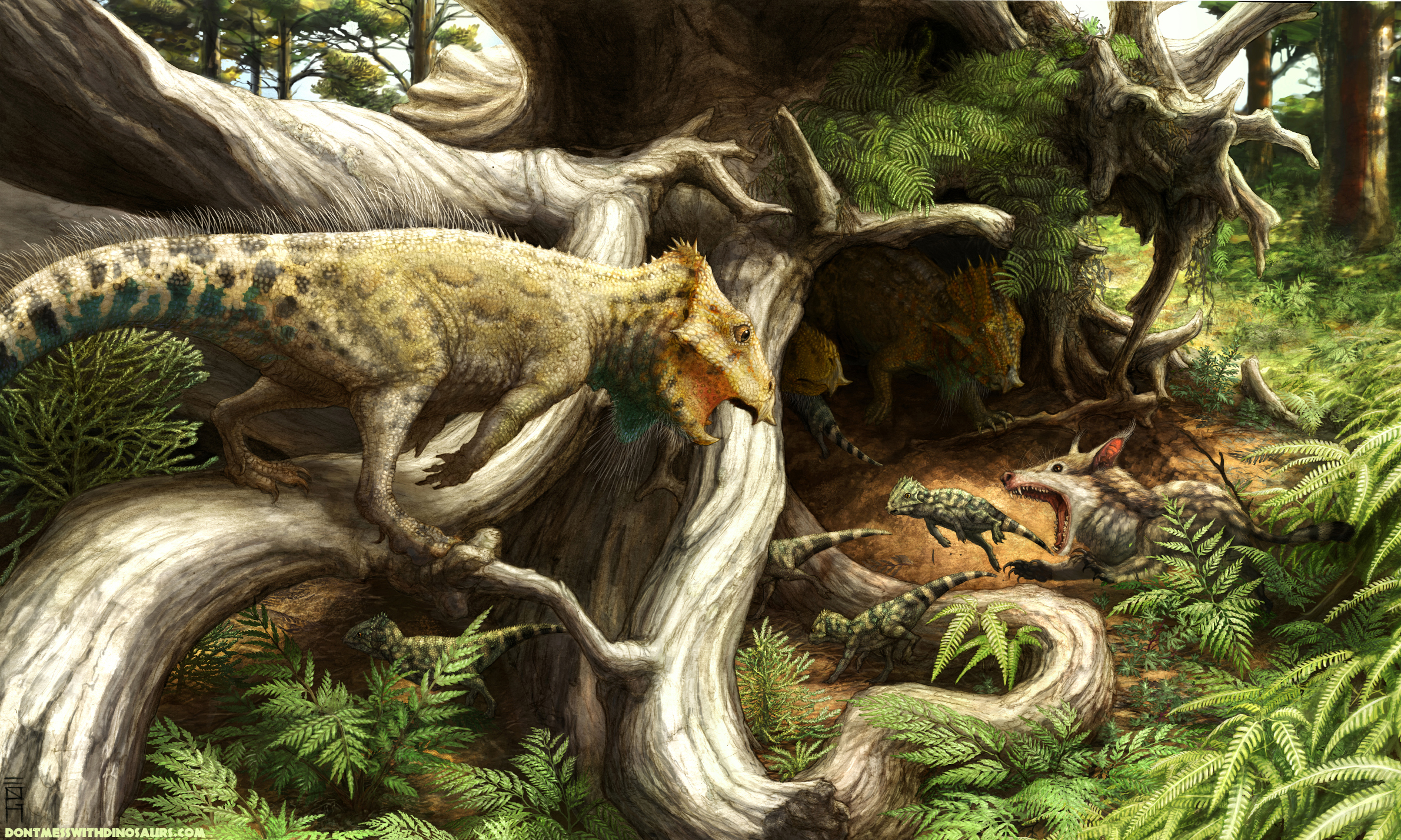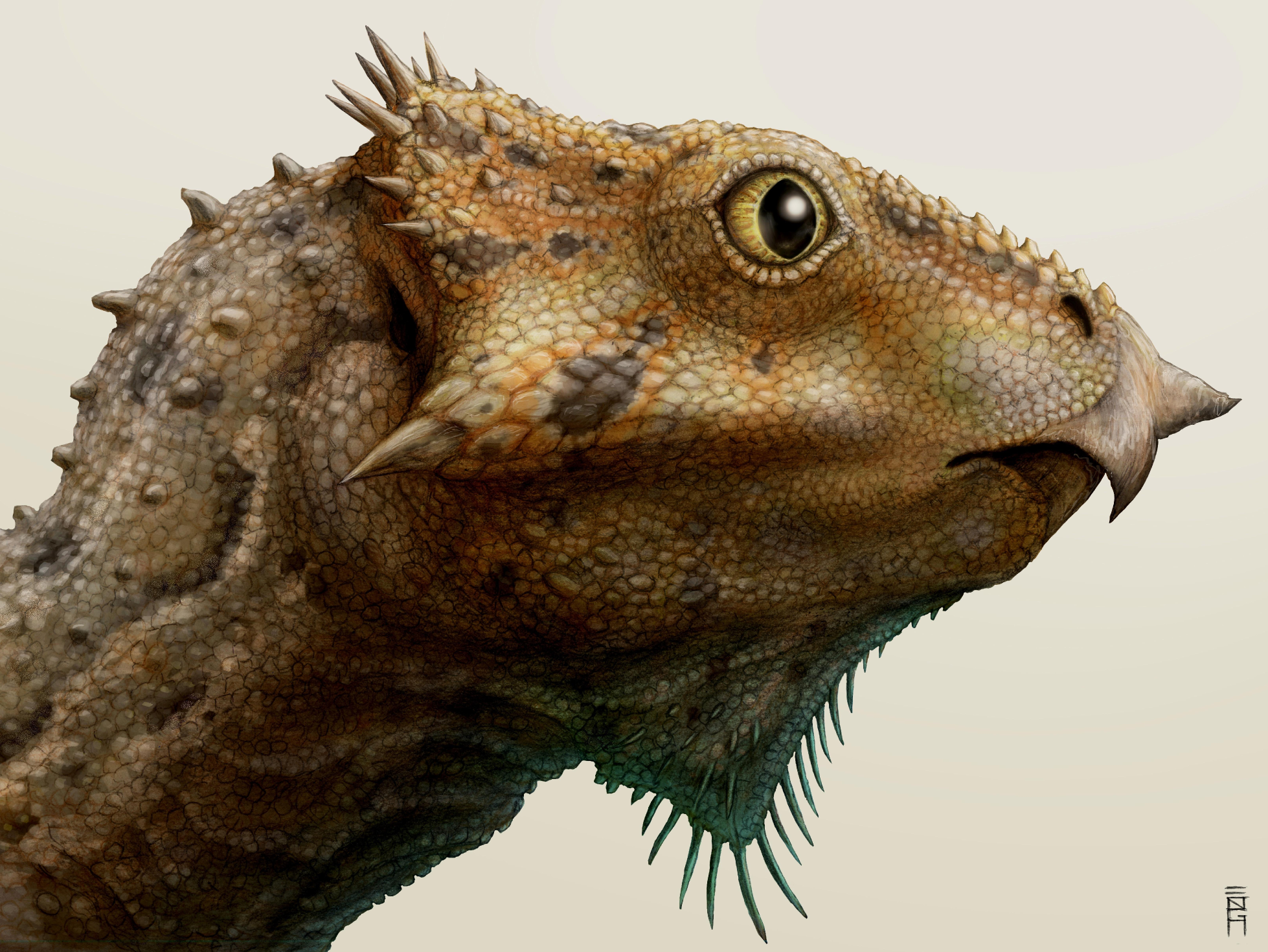|
Gobiconodon
''Gobiconodon'' is an extinct genus of carnivorous mammal from the Middle Jurassic to Early Cretaceous. It weighed , had a skull of in length, and had in presacral body length. It was one of the largest mammals known from the Mesozoic. Like other gobiconodontids, it possesses several speciations towards carnivory, such as shearing molar teeth, large canine-like incisors and powerful jaw and forelimb musculature, indicating that it probably fed on vertebrate prey; rather uniquely among predatory mammals and other eutriconodonts, the lower canines were vestigial, with the first lower incisor pair having become massive and canine-like. Like the larger ''Repenomamus'' there might be some evidence of scavenging Scavengers are animals that consume dead organisms that have died from causes other than predation or have been killed by other predators. While scavenging generally refers to carnivores feeding on carrion, it is also a herbivorous feeding be ....Zofia Kielan-Jaworo ... [...More Info...] [...Related Items...] OR: [Wikipedia] [Google] [Baidu] |
Gobiconodontidae
Gobiconodontidae is a family of extinct mammals that ranged from the mid-Jurassic to the early Late Cretaceous, though most common during the Early Cretaceous. The Gobiconodontids form a diverse lineage of carnivorous non-therian mammals, and include some of the best preserved Mesozoic mammal specimens. Biology Like many other non-therian mammals, gobiocontids retained classical mammalian synapomorphies like epipubic bones (and likely the associated reproductive constrictions), venomous spurs and sprawling limbs. Through ''Spinolestes'' we also know that they had fur similar to that of modern mammals, with compound hair follicles with primary and secondary hairs. ''Spinolestes'' also possesses a clear diaphragm like modern mammals, as well as spines, dermal scutes and an ossified Meckel's cartilage. Furthermore, it may also display signs of dermatophytosis, suggesting that gobiconodontids, like modern mammals, were vulnerable to this type of fungal infection. Gobiconodontid ... [...More Info...] [...Related Items...] OR: [Wikipedia] [Google] [Baidu] |
Largest Prehistoric Animals
The largest prehistoric animals include both vertebrate and invertebrate species. Many of them are described below, along with their typical range of size (for the general dates of extinction, see the link to each). Many species mentioned might not actually be the largest representative of their clade due to the incompleteness of the fossil record and many of the sizes given are merely estimates since no complete specimen have been found. Their body mass, especially, is largely conjecture because soft tissue was rarely fossilized. Generally the size of extinct species was subject to energetic and biomechanical constraints. Non-mammalian synapsids (Synapsida) Caseasaurs (Caseasauria) The herbivorous ''Alierasaurus'' was the largest caseid and the largest amniote to have lived at the time, with an estimated length around . '' Cotylorhynchus hancocki'' is also large, with an estimated length and weight of at least and more than . Edaphosaurids (Edaphosauridae) The larges ... [...More Info...] [...Related Items...] OR: [Wikipedia] [Google] [Baidu] |
Repenomamus
''Repenomamus'' (Latin: "reptile" (reptilis), "mammal" (mammalis)) is a genus of opossum- to badger-sized gobiconodontid mammal containing two species, ''Repenomamus robustus'' and ''Repenomamus giganticus''. Both species are known from fossils found in China that date to the early Cretaceous period, about 125-123.2 million years ago. ''R. robustus'' is one of several Mesozoic mammals for which there is good evidence that it fed on vertebrates, including dinosaurs, though it is not possible to determine if it actively hunted live dinosaurs or scavenged dead ones. ''R. giganticus'' is among the largest mammals known from the Mesozoic era. Classification and discovery The fossils were recovered from the lagerstätte of the Yixian Formation in the Liaoning province of China, which is renowned for its extraordinarily well-preserved fossils of feathered dinosaurs. They have been specifically dated to 125–123.2 million years ago, during the Early Cretaceous period. ''Repenomamus'' ... [...More Info...] [...Related Items...] OR: [Wikipedia] [Google] [Baidu] |
Cloverly Formation
The Cloverly Formation is a geological formation of Early and Late Cretaceous age (Valanginian to Cenomanian stage) that is present in parts of Montana, Wyoming, Colorado and Utah in the western United States. It was named for a post office on the eastern side of the Bighorn Basin in Wyoming by N.H. Darton in 1904. The sedimentary rocks of formation were deposited in floodplain environments and contain vertebrate fossils, including a diverse assemblage of dinosaur remains. In 1973, the Cloverly Formation Site was designated as a National Natural Landmark by the National Park Service. Stratigraphy The Cloverly Formation rests disconformably on the Morrison Formation and is conformably overlain by the Thermopolis Shale. It is subdivided into a variety of members, depending on the location.Moberly, R.M., Jr., 1960, Morrison, Cloverly, and Sykes Mountain formations, northern Bighorn basin, Wyoming and Montana: Geological Society of America Bulletin, v. 71, no. 8, p. 1137-1176. In t ... [...More Info...] [...Related Items...] OR: [Wikipedia] [Google] [Baidu] |
Ilek Formation
The Ilek Formation is a Lower Cretaceous geologic formation in Western Siberia. Many different fossils have been recovered from the formation. It overlies the Late Jurassic Tyazhin Formation and underlies the Albian Kiya Formation. The formation was described by L. A. Ragozin in 1935. It consists of sands with sandstone concretions, layers of silts, clays and marls. Age of the formation, according to a crude 1962 estimate, is Valanginian(?) - Hauterivian - Barremian. Its thickness varies greatly, reaching 746 m in Teguldet borehole. Fauna A fragmentary wing metatarsal nearly identical to the pterosaur ''Lonchognathosaurus'' is also known. See also * List of pterosaur-bearing stratigraphic units This is a list of stratigraphic units, where pterosaur fossils have been recovered from. Units listed are all either formation rank or higher (e.g. group). See also * Pterosaur * List of fossil sites References Further reading * Ext ... References {{Refli ... [...More Info...] [...Related Items...] OR: [Wikipedia] [Google] [Baidu] |
Aquilops Americanus Restoration
''Aquilops'' is an early herbivorous ceratopsian dinosaur dating from the Early Cretaceous of North America, approximately 109 million to 104 million years ago. The type species is ''A. americanus''. Description The skull is 84.2 mm long. The holotype is possibly not from a full-grown individual. A comparison with related species indicates it might have been at 60% of its adult length. Wedel estimated the total body length of ''Aquilops'' at 60 cm and its weight at 1.5 kg. The authors established some unique traits. The rostral, the bone core of the snout beak, curves downwards and has an arched keel on its top with a bump on the front. In front of the tooth row the upper jaw rim is over its total length concave in side view. The skull opening, the antorbital fenestra, is twice as long as it is tall and has a pointed rear, below the eye socket. Discovery and naming In 1997, paleontologist Scott Madsen found the single fossil, a partial skull, in Carbon County ... [...More Info...] [...Related Items...] OR: [Wikipedia] [Google] [Baidu] |
Mammal
Mammals () are a group of vertebrate animals constituting the class Mammalia (), characterized by the presence of mammary glands which in females produce milk for feeding (nursing) their young, a neocortex (a region of the brain), fur or hair, and three middle ear bones. These characteristics distinguish them from reptiles (including birds) from which they diverged in the Carboniferous, over 300 million years ago. Around 6,400 extant species of mammals have been described divided into 29 orders. The largest orders, in terms of number of species, are the rodents, bats, and Eulipotyphla (hedgehogs, moles, shrews, and others). The next three are the Primates (including humans, apes, monkeys, and others), the Artiodactyla ( cetaceans and even-toed ungulates), and the Carnivora (cats, dogs, seals, and others). In terms of cladistics, which reflects evolutionary history, mammals are the only living members of the Synapsida (synapsids); this clade, together with Saur ... [...More Info...] [...Related Items...] OR: [Wikipedia] [Google] [Baidu] |
Ksar Metlili Formation
The Ksar Metlili Formation is a geological formation in eastern High Atlas of Morocco, it is late Tithonian to Berriasian In the geological timescale, the Berriasian is an age/stage of the Early/Lower Cretaceous. It is the oldest subdivision in the entire Cretaceous. It has been taken to span the time between 145.0 ± 4.0 Ma and 139.8 ± 3.0 Ma (million years ago) ... in age. It is approximately thick and primarily consists of mudstone and sandstone, with thin calcareous beds. One of these calcareous beds near the middle of the sequence is an important microvertebrate locality. Subsequent to the original site, several other localities have been sampled. The depositional environment is thought to be near shore deltaic. Fossil content Amphibians Lepidosaurs Dinosaurs Mammals References {{reflist Geologic formations of Morocco Jurassic System of Africa Tithonian Stage Jurassic Morocco Upper Cretaceous Series of Africa Berriasian Stage Cretaceous Mor ... [...More Info...] [...Related Items...] OR: [Wikipedia] [Google] [Baidu] |
Oshih Formation
The Khuren Dukh Formation, also known as the Hühteeg Svita, ( mn, Хөхтээг формаци, ) is a geological formation in Mongolia whose strata date back to the middle to late Albian.Nichols et al., 2006 Dinosaur remains are among the fossils that have been recovered from the formation.Weishampel et al., 2004, pp.563-570 Vertebrate paleofauna Dinosaurs Choristoderes See also * List of dinosaur-bearing rock formations This list of dinosaur-bearing rock formations is a list of geologic formations in which dinosaur fossils have been documented. Containing body fossils * List of stratigraphic units with dinosaur body fossils ** List of stratigraphic units with few ... References Bibliography * * * * {{DEFAULTSORT:Huhteeg Svita Geologic formations of Mongolia Lower Cretaceous Series of Asia Cretaceous Mongolia Albian Stage Sandstone formations Mudstone formations Lacustrine deposits Paleontology in Mongolia Formations ... [...More Info...] [...Related Items...] OR: [Wikipedia] [Google] [Baidu] |
Siberia
Siberia ( ; rus, Сибирь, r=Sibir', p=sʲɪˈbʲirʲ, a=Ru-Сибирь.ogg) is an extensive geographical region, constituting all of North Asia, from the Ural Mountains in the west to the Pacific Ocean in the east. It has been a part of Russia since the latter half of the 16th century, after the Russians conquered lands east of the Ural Mountains. Siberia is vast and sparsely populated, covering an area of over , but home to merely one-fifth of Russia's population. Novosibirsk, Krasnoyarsk and Omsk are the largest cities in the region. Because Siberia is a geographic and historic region and not a political entity, there is no single precise definition of its territorial borders. Traditionally, Siberia extends eastwards from the Ural Mountains to the Pacific Ocean, and includes most of the drainage basin of the Arctic Ocean. The river Yenisey divides Siberia into two parts, Western and Eastern. Siberia stretches southwards from the Arctic Ocean to the hills of north-ce ... [...More Info...] [...Related Items...] OR: [Wikipedia] [Google] [Baidu] |
Bathonian
In the geologic timescale the Bathonian is an age and stage of the Middle Jurassic. It lasted from approximately 168.3 Ma to around 166.1 Ma (million years ago). The Bathonian Age succeeds the Bajocian Age and precedes the Callovian Age. Stratigraphic definitions The Bathonian Stage takes its name from Bath, a spa town in England built on Jurassic limestone (the Latinized form of the town name is ''Bathonium''). The name was introduced in scientific literature by Belgian geologist d'Omalius d'Halloy in 1843. The original type locality was located near Bath. The French palaeontologist Alcide d'Orbigny was in 1852 the first to define the exact length of the stage. The base of the Bathonian is at the first appearance of ammonite species '' Parkinsonia (Gonolkites) convergens'' in the stratigraphic column. The global reference profile for the base of the Bathonian (a GSSP) was ratified as Ravin du Bès, Bas-Auran area, Alpes de Haute Provence, France in 2009. The top of the Bat ... [...More Info...] [...Related Items...] OR: [Wikipedia] [Google] [Baidu] |




